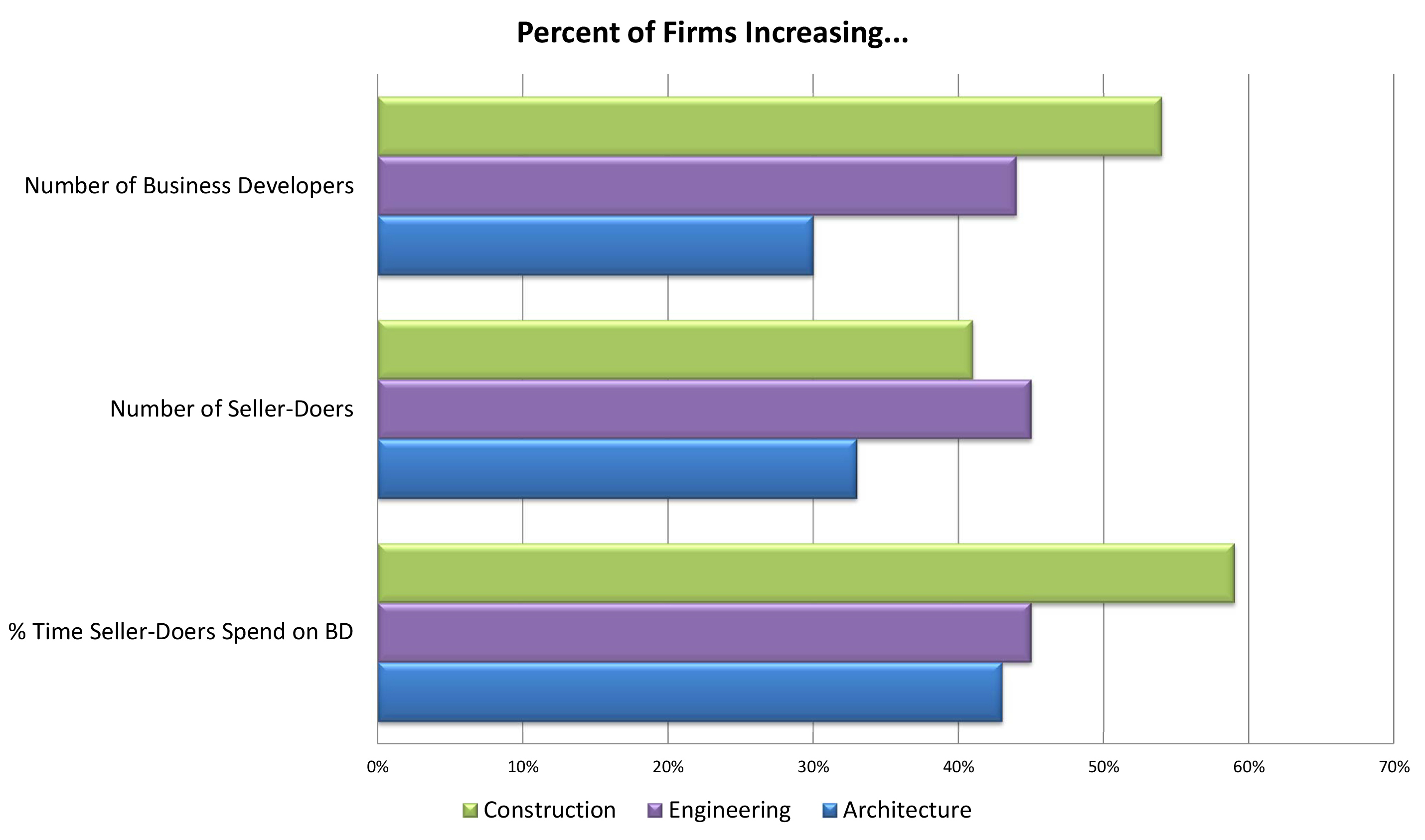During the past year, the Society for Marketing Professional Services (SMPS) and the SMPS Foundation have been researching how architecture, engineering, and construction firms are doing business development (BD). In the process, they received more than 1,300 surveys from every size and type of A/E/C firm imaginable. A deeper dive into the research entailed interviews with more than forty of the participants to gain a greater understanding into current trends in business development.
Disclaimer: I was very active with the research design, working with the research consultant, and recently authored the resulting research publication, Sell. Do. Win Business. A Report on How A/E/C Firms Are Using Staff to Win More Work.
One of the primary drivers to conduct the research was to look at the who. That is, how are firms staffing business development? Two primary staff categories were identified: business developers, which are dedicated sales professionals – often non-technical – whose primary focus is to generate business for their firms, and seller-doers, technical professionals like principals and project managers and lead architects/engineers, who balance billable work with business development pursuits.
Of keen interest to SMPS researchers was some resolution to that age-old question: dedicated business developers or technical-oriented seller-doers? Which do A/E/C firms prefer?
Well, the verdict is in. And the answer is … wait for it … BOTH!
Certainly there are firms that only use seller-doers. And others that only use dedicated business developers. Yet if there is a “common” model in this industry, it is perhaps a hybrid. Firms see value in both roles, and there’s a complementary relationship, not a competitive one.
Survey participants included members of the Society for Marketing Professional Services (SMPS), American Institute of Architects (AIA), Associated General Contractors of America (AGC), and National Council of Structural Engineering Associations (NCSEA).
Not surprisingly, smaller firms tended to have no business developers on staff, while larger firms tended to employ dedicated business developers. Yet even 19% of firms with fewer than five employees have a dedicated business developer, while 8% of firms with more than 500 employees don’t have any dedicated business developers. In this survey, the majority of firms with more than 25 employees noted that they employ dedicated business developers.
SMPS wanted to see if the model had changed over the past decade, and found that firms are increasingly relying on both dedicated business developers and seller-doers.


This chart shows that a significant number of A/E/C firms have been ramping up their business development efforts. There’s a commonly-held belief that when times are good, firms hire business developers. Then, when times are slow, they get rid of business developers and rely on seller-doers. But comparing the “now” with ten years ago, we’ve had The Great Recession sandwiched in the middle. And while the economic recovery continues to be uneven – depending upon geographic region and market sectors served – we see that despite significant growth in the A/E/C industry over the past few years, firms are still hiring in both sales and seller-doer positions.
Furthermore, the time that seller-doers spend doing business development has increased compared with ten years ago.
Roughly a third of architectural firms have added dedicated business developers as well as seller-doers, with a slight edge to seller-doers. More than 40% of architectural firms have increased the time that seller-doers spend with sales pursuits.
For engineering, roughly 45% of firms have increased the number of dedicated business developers and seller-doers on staff, with the same number of firms increasing the time that seller-doers spend on BD.
More than half of construction firms have added business developers, while about 40% of firms have also added seller-doers. The edge here goes to dedicated business developers; however, almost 60% of construction firms have experienced increases in the amount of time that their seller-doers spend on BD, the largest group in the survey.
So how do these positions co-exist?
In general terms, business developers are door openers and trainers, while seller-doers are closers. Business developers have a heavy emphasis on new client development while seller-doers focus more on existing accounts, which represent the bulk of most firms’ annual volume. Industry studies generally have found that approximately 80% of an A/E/C firm’s annual volume comes from repeat clients, which demonstrates the importance in being proactive with maintaining and expanding relationships with existing clients.
The top responsibilities of dedicated business developers include:
- Arranging meetings with potential clients
- Participating in client meetings
- Participating in client organizations
- Attending trade shows
- Conducting market research
Conversely, the top business development responsibilities of seller-doers are:
- Participating in client meetings
- Participating in client shortlist presentations
- Writing proposals
- Setting up appointments with potential clients
- Participating in client organizations
My opinion is of course biased, but I feel there is a lot of great information in this report, which, by the way, is free for download!
Some of the topics covered include:
- Percentage of technical staff with BD responsibilities by firm size
- Titles or functions of seller-doers
- Responsibilities of business developers and seller-doers
- Primary reasons to use the seller-doer model
- Success of BD practices by firm size / status
- Positions with personal BD goals
- Preferred seller-doer training formats
- Anticipated changes in BD practices over the next ten years
- … and more.
Ultimately, there is no “one size fits all” approach to business development. Smaller firms and A/E firms tend to use more seller-doers, while larger firms and construction firms lean toward dedicated business developers. However, the vast majority of A/E/C firms use both positions effectively, incorporating team-based selling where everyone has a unique position to play and knows their specific roles.
What do you think? Are both positions critical for A/E/C firms, or is one more effective than the other?


Post a comment to this article
Report Abusive Comment